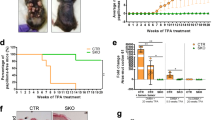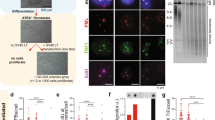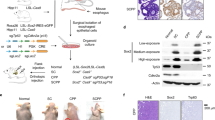Abstract
Immortalization (senescence bypass) is a critical rate-limiting step in the malignant transformation of mammalian somatic cells. Human cells must breach at least two distinct senescence barriers to permit unfettered clonal evolution during cancer development: (1) stress- or oncogene-induced premature senescence (SIPS/OIS), mediated via the p16–Rb and/or ARF–p53–p21 tumour-suppressive pathways, and (2) replicative senescence triggered by telomere shortening. In contrast, because their telomerase is constitutively active, cells from small rodents possess only the SIPS/OIS barrier, and are therefore useful for studying SIPS/OIS bypass in isolation. Dermal fibroblasts from the Syrian hamster (SHD cells) are exceptionally resistant to spontaneous SIPS bypass, but it can be readily induced following exposure to a wide range of chemical and physical carcinogens. Here we show that a spectrum of carcinogen-specific mutational and epigenetic alterations involving the INK4A (p16), p53 and INK4B (p15) genes are associated with induced SIPS bypass. With ionizing radiation, immortalization is invariably accompanied by efficient biallelic deletion of the complete INK4/CDKN2 locus. In comparison, SHD cells immortalized by the powerful polycyclic hydrocarbon carcinogen benzo(a)pyrene display transversion point mutations in the DNA-binding domain of p53 coupled with INK4 alterations such as loss of expression of p15. Epimutational silencing of p16 is the primary event associated with immortalization by nickel, a human non-genotoxic carcinogen. As SIPS/OIS bypass is a prerequisite for the immortalization of normal diploid human epithelial cells, our results with the SHD model will provide a basis for delineating combinations of key molecular changes underpinning this important event in human carcinogenesis.
This is a preview of subscription content, access via your institution
Access options
Subscribe to this journal
Receive 50 print issues and online access
$259.00 per year
only $5.18 per issue
Buy this article
- Purchase on Springer Link
- Instant access to full article PDF
Prices may be subject to local taxes which are calculated during checkout


Similar content being viewed by others
References
Newbold RF . Cellular immortalization and telomerase activation in cancer. In: Knowles M, Selby P (eds) Introduction to the Cellular and Molecular Biology of Cancer 4th edn. Oxford University Press: Oxford 2005. pp 170–185.
Sikora E, Arendt T, Bennett M, Narita M . Impact of cellular senescence signature on ageing research. Ageing Res Rev 2011; 10: 146–152.
Russo I, Silver A, Cuthbert A, Griffin D, Trott D, Newbold R . A telomere-independent senescence mechanism is the sole barrier to Syrian hamster cell immortalization. Oncogene 1998; 17: 3417–3426.
Seluanov A, Hine C, Bozzella M, Hall A, Sasahara TH, Ribeiro AA et al. Distinct tumor suppressor mechanisms evolve in rodent species that differ in size and lifespan. Aging Cell 2008; 7: 813–823.
Campisi J . Cellular senescence as a tumor-suppressor mechanism. Trends Cell Biol 2001; 11: S27–S31.
Serrano M, Lin AW, McCurrach ME, Beach D, Lowe SW . Oncogenic ras provokes premature cell senescence associated with accumulation of p53 and p16INK4a. Cell 1997; 88: 593–602.
Collado M, Serrano M . Senescence in tumours: evidence from mice and humans. Nat Rev Cancer 2010; 10: 51–57.
Trott D, Cuthbert A, Overell R, Russo I, Newbold R . Mechanisms involved in the immortalization of mammalian cells by ionizing radiation and chemical carcinogens. Carcinogenesis 1995; 16: 193–204.
Newbold R, Overell R, Connell J . Induction of immortality is an early event in malignant transformation of mammalian cells by carcinogens. Nature 1982; 299: 633–635.
Newbold R, Overell R . Fibroblast immortality is a prerequisite for transformation by EJ c-Ha-ras oncogene. Nature 1983; 304: 648–651.
Creton S, Aardema MJ, Carmichael PL, Harvey JS, Martin FL, Newbold RF et al. Cell transformation assays for prediction of carcinogenic potential: state of the science and future research needs. Mutagenesis 2011; 27: 93–101.
Newbold RF, Wigley CB, Thompson MH, Brookes P . Cell-mediated mutagenesis in cultured Chinese hamster cells by carcinogenic polycyclic hydrocarbons: nature and extent of the associated hydrocarbon-DNA reaction. Mutat Res 1977; 43: 101–116.
Newbold R, Brookes P . Exceptional mutagenicity of a benzo(a)pyrene diol epoxide in cultured mammalian cells. Nature 1976; 261: 52–54.
Newbold R, Warren W, Medcalf A, Amos J . Mutagenicity of carcinogenic methylating agents is associated with a specific DNA modification. Nature 1980; 283: 596–599.
Arita A, Costa M . Epigenetics in metal carcinogenesis: nickel, arsenic, chromium and cadmium. Metallomics 2009; 1: 222–228.
Ruas M, Peters G . The p16INK4a/CDKN2A tumor suppressor and its relatives. Biochim Biophys Acta 1998; 1378: F115–F177.
Csepregi A, Ebert MP, Röcken C, Schneider-Stock R, Hoffmann J, Schulz HU et al. Promoter methylation of CDKN2A and lack of p16 expression characterize patients with hepatocellular carcinoma. BMC Cancer 2010; 10: 317.
Goh AM, Coffill CR, Lane DP . The role of mutant p53 in human cancer. J Pathol 2011; 223: 116–126.
Whibley C, Odell A, Nedelko T, Balaburski G, Murphy M, Liu Z et al. Wild-type and Hupki (human p53 knock-in) murine embryonic fibroblasts: p53/ARF pathway disruption in spontaneous escape from senescence. J Biol Chem 2010; 285: 11326–11335.
Odell A, Askham J, Whibley C, Hollstein M . How to become immortal: let MEFs count the ways. Aging (Albany NY) 2010; 2: 160–165.
Chang K, Laconi S, Mangold K, Hubchak S, Scarpelli D . Multiple genetic alterations in hamster pancreatic ductal adenocarcinomas. Cancer Res 1995; 55: 2560–2568.
Chang K, Mangold K, Hubchak S, Laconi S, Scarpelli D . Genomic p53 mutation in a chemically induced hamster pancreatic ductal adenocarcinoma. Cancer Res 1994; 54: 3878–3883.
Chang K, Lin S, Koos S, Pather K, Solt D . p53 and Ha-ras mutations in chemically induced hamster buccal pouch carcinomas. Carcinogenesis 1996; 17: 595–600.
Chang K, Sarraj S, Lin S, Tsai P, Solt D . P53 expression, p53 and Ha-ras mutation and telomerase activation during nitrosamine-mediated hamster pouch carcinogenesis. Carcinogenesis 2000; 21: 1441–1451.
Gimenez-Conti I, LaBate M, Liu F, Osterndorff E . p53 alterations in chemically induced hamster cheek-pouch lesions. Mol Carcinog 1996; 16: 197–202.
Oreffo V, Lin H, Padmanabhan R, Witschi H . K-ras and p53 point mutations in 4-(methylnitrosamino)-1-(3-pyridyl)-1-butanone-induced hamster lung tumors. Carcinogenesis 1993; 14: 451–455.
Legros Y, McIntyre P, Soussi T . The cDNA cloning and immunological characterization of hamster p53. Gene 1992; 112: 247–250.
Popescu N, Zimonjic D, Albor A, Notario V . Localization of the Tp53 gene on Syrian hamster chromosome 9 by fluorescence in situ hybridization. Cytogenet Cell Genet 1995; 68: 71–73.
Ling H, Sayer JM, Plosky BS, Yagi H, Boudsocq F, Woodgate R et al. Crystal structure of a benzo[a]pyrene diol epoxide adduct in a ternary complex with a DNA polymerase. Proc Natl Acad Sci USA 2004; 101: 2265–2269.
Li J, Weghorst C, Tsutsumi M, Poi M, Knobloch T, Casto B et al. Frequent p16INK4A/CDKN2A alterations in chemically induced Syrian golden hamster pancreatic tumors. Carcinogenesis 2004; 25: 263–268.
Li J, Warner B, Casto B, Knobloch T, Weghorst C . Tumor suppressor p16(INK4A)/Cdkn2a alterations in 7, 12-dimethylbenz(a)anthracene (DMBA)-induced hamster cheek pouch tumors. Mol Carcinog 2008; 47: 733–738.
Muscarella P, Knobloch T, Ulrich A, Casto B, Moniaux N, Wittel U et al. Identification and sequencing of the Syrian Golden hamster (Mesocricetus auratus) p16(INK4a) and p15(INK4b) cDNAs and their homozygous gene deletion in cheek pouch and pancreatic tumor cells. Gene 2001; 278: 235–243.
Li J, Qin D, Knobloch T, Tsai M, Weghorst C, Melvin W et al. Expression and characterization of Syrian golden hamster p16, a homologue of human tumor suppressor p16 INK4A. Biochem Biophys Res Commun 2003; 304: 241–247.
Hanaoka M, Shimizu K, Shigemura M, Kato A, Fujii H, Honoki K et al. Cloning of the hamster p16 gene 5′ upstream region and its aberrant methylation patterns in pancreatic cancer. Biochem Biophys Res Commun 2005; 333: 1249–1253.
Haga K, Ohno S, Yugawa T, Narisawa-Saito M, Fujita M, Sakamoto M et al. Efficient immortalization of primary human cells by p16INK4a-specific short hairpin RNA or Bmi-1, combined with introduction of hTERT. Cancer Sci 2007; 98: 147–154.
Yaswen P, Stampfer MR . Molecular changes accompanying senescence and immortalization of cultured human mammary epithelial cells. Int J Biochem Cell Biol 2002; 34: 1382–1394.
Sherr CJ, DePinho RA . Cellular senescence: mitotic clock or culture shock? Cell 2000; 102: 407–410.
Camacho CV, Mukherjee B, McEllin B, Ding LH, Hu B, Habib AA et al. Loss of p15/Ink4b accompanies tumorigenesis triggered by complex DNA double-strand breaks. Carcinogenesis 2010; 31: 1889–1896.
Florl AR, Schulz WA . Peculiar structure and location of 9p21 homozygous deletion breakpoints in human cancer cells. Genes Chromosomes Cancer 2003; 37: 141–148.
Grafström E, Egyházi S, Ringborg U, Hansson J, Platz A . Biallelic deletions in INK4 in cutaneous melanoma are common and associated with decreased survival. Clin Cancer Res 2005; 11: 2991–2997.
Bignell GR, Greenman CD, Davies H, Butler AP, Edkins S, Andrews JM et al. Signatures of mutation and selection in the cancer genome. Nature 2010; 463: 893–898.
Raschke S, Balz V, Efferth T, Schulz WA, Florl AR . Homozygous deletions of CDKN2A caused by alternative mechanisms in various human cancer cell lines. Genes Chromosomes Cancer 2005; 42: 58–67.
Windhofer F, Krause S, Hader C, Schulz WA, Florl AR . Distinctive differences in DNA double-strand break repair between normal urothelial and urothelial carcinoma cells. Mutat Res 2008; 638: 56–65.
Garbe JC, Bhattacharya S, Merchant B, Bassett E, Swisshelm K, Feiler HS et al. Molecular distinctions between stasis and telomere attrition senescence barriers shown by long-term culture of normal human mammary epithelial cells. Cancer Res 2009; 69: 7557–7568.
Liu Z, Muehlbauer KR, Schmeiser HH, Hergenhahn M, Belharazem D, Hollstein MC . p53 mutations in benzo(a)pyrene-exposed human p53 knock-in murine fibroblasts correlate with p53 mutations in human lung tumors. Cancer Res 2005; 65: 2583–2587.
Krimpenfort P, Ijpenberg A, Song JY, van der Valk M, Nawijn M, Zevenhoven J et al. p15Ink4b is a critical tumour suppressor in the absence of p16Ink4a. Nature 2007; 448: 943–946.
Peters G . An INKlination for epigenetic control of senescence. Nat Struct Mol Biol 2008; 15: 1133–1134.
He J, Kallin EM, Tsukada Y, Zhang Y . The H3K36 demethylase Jhdm1b/Kdm2b regulates cell proliferation and senescence through p15(Ink4b). Nat Struct Mol Biol 2008; 15: 1169–1175.
Lam T, Ruczinski I, Helzlsouer K, Shugart Y, Li K, Clipp S et al. Copy number variants of GSTM1 and GSTT1 in relation to lung cancer risk in a prospective cohort study. Ann Epidemiol 2009; 19: 546–552.
Li LC, Dahiya R . MethPrimer: designing primers for methylation PCRs. Bioinformatics 2002; 18: 1427–1431.
Acknowledgements
This work was fully funded by triennial Project Grant to RFN and MO’D (ID G0800697/1) from the (UK) National Centre for the Replacement, Refinement and Reduction of Animals in Research (NC3Rs). JCP is funded by a UK BBSRC-CASE Studentship award with Unilever Plc. EG was funded by a grant from AstraZeneca. We acknowledge Mrs Alison Marriott and Dr Rana Hasan for their expert technical assistance. We dedicate this article to colleagues Professor Philip D Lawley (1927–2011) who pioneered research into the reaction of alkylating carcinogens with DNA; and to Steven Pash (1955–2011) who assisted expertly with the generation of hamster cell cultures.
Author information
Authors and Affiliations
Corresponding author
Ethics declarations
Competing interests
The authors declare no conflict of interest.
Additional information
Supplementary Information accompanies the paper on the Oncogene website
Rights and permissions
About this article
Cite this article
Yasaei, H., Gilham, E., Pickles, J. et al. Carcinogen-specific mutational and epigenetic alterations in INK4A, INK4B and p53 tumour-suppressor genes drive induced senescence bypass in normal diploid mammalian cells. Oncogene 32, 171–179 (2013). https://doi.org/10.1038/onc.2012.45
Received:
Revised:
Accepted:
Published:
Issue Date:
DOI: https://doi.org/10.1038/onc.2012.45
Keywords
This article is cited by
-
Artificial intelligence uncovers carcinogenic human metabolites
Nature Chemical Biology (2022)
-
Cellular senescence: the good, the bad and the unknown
Nature Reviews Nephrology (2022)
-
A prospect of cell immortalization combined with matrix microenvironmental optimization strategy for tissue engineering and regeneration
Cell & Bioscience (2019)
-
Senescence and aging: the critical roles of p53
Oncogene (2013)



